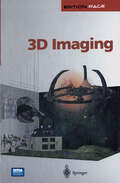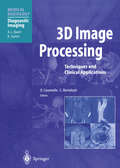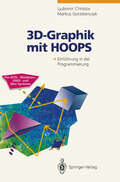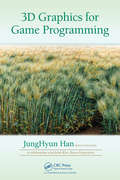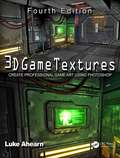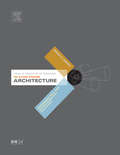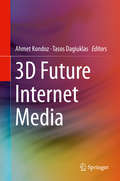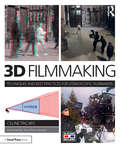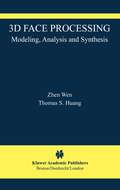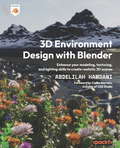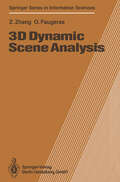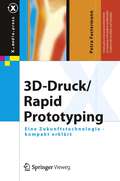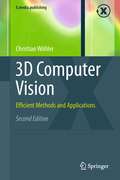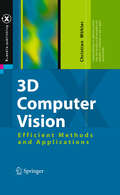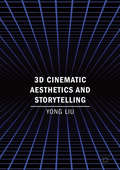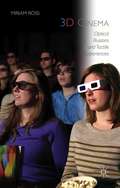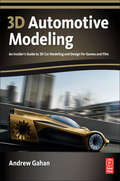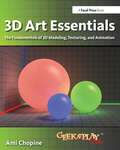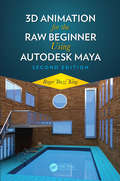- Table View
- List View
3D Image Processing: Techniques and Clinical Applications (Medical Radiology)
by A. L. Baert D. Caramella C. BartolozziFew fields have witnessed such impressive advances as the application of computer technology to radiology. The progress achieved has revolutionized diagnosis and greatly facilitated treatment selection and accurate planning of procedures. This book, written by leading experts from many different countries, provides a comprehensive and up-to-date overview of the role of 3D image processing. The first section covers a wide range of technical aspects in an informative way. This is followed by the main section, in which the principal clinical applications are described and discussed in depth. To complete the picture, the final section focuses on recent developments in functional imaging and computer-aided surgery. This book will prove invaluable to all who have an interest in this complex but vitally important field.
3D-Graphik mit HOOPS: Einführung in die Programmierung
by Ljubomir Christov Markus GorzelanczykDieses Buch ist sowohl eine systematische Einführung in das 3D-Grafiksystem HOOPS (Hierarchical Object-Oriented Picture System) als auch ein ausführliches Handbuch für dessen Programmierung. Es wird vorausgesetzt, daß der Benutzer die Grundbegriffe der Computergrafik beherrscht. Der Neuling, der Hoops kennen- und nutzen lernen möchte, kann das Buch als Lehrbuch verwenden. Jedes Kapitel behandelt einen abgeschlossenen Aspekt von Hoops. Dabei werden die jeweils relevanten Prozeduren zusammengefaßt und kurz erläutert. Anschauliche Beispiele erleichtern das Verständnis. Der schon mit Hoops vertraute Leser kann das Buch als Nachschlagewerk für die Programmierung benutzen. Eine ausführliche Prozedur-Referenz rundet das Buch ab. Mit zahlreichen Programmierbeispielen in C.
3D Graphics for Game Programming
by JungHyun HanDesigned for advanced undergraduate and beginning graduate courses, 3D Graphics for Game Programming presents must-know information for success in interactive graphics. Assuming a minimal prerequisite understanding of vectors and matrices, it also provides sufficient mathematical background for game developers to combine their previous experie
3D Game Textures: Create Professional Game Art Using Photoshop
by Luke AhearnThe new edition of 3D Game Textures: Create Professional Game Art Using Photoshop features the most up-to-date techniques that allow you to create your own unique textures, shaders, and materials. Revised to take new technology into account, it is an ideal hands-on resource for creating online worlds, simulations, web-based applications, and architectural visualization projects. Continuing the practical, no-nonsense approach of its predecessors, the fourth edition shows you how to advance your digital art skills with textures and shaders by exploring their interactions in single objects or entire scenes. It contains expanded coverage of shader nodes, and the companion website—www.lukeahearn.com/textures—has been updated to include video tutorials as well as updated sample textures, shaders, materials, actions, brushes, and all of the art from the book.
3D Game Textures: Create Professional Game Art Using Photoshop
by Luke AhearnThe new edition of 3D Game Textures: Create Professional Game Art Using Photoshop features the most up-to-date techniques that allow you to create your own unique textures, shaders, and materials. Revised to take new technology into account, it is an ideal hands-on resource for creating online worlds, simulations, web-based applications, and architectural visualization projects. Continuing the practical, no-nonsense approach of its predecessors, the fourth edition shows you how to advance your digital art skills with textures and shaders by exploring their interactions in single objects or entire scenes. It contains expanded coverage of shader nodes, and the companion website—www.lukeahearn.com/textures—has been updated to include video tutorials as well as updated sample textures, shaders, materials, actions, brushes, and all of the art from the book.
3D Game Engine Architecture: Engineering Real-Time Applications with Wild Magic
by David EberlyDave Eberly's 3D Game Engine Design was the first professional guide to the essential concepts and algorithms of real-time 3D engines and quickly became a classic of game development. Dave's new book 3D Game Engine Architecture continues the tradition with a comprehensive look at the software engineering and programming of 3D engines. This book is
3D Future Internet Media
by Ahmet Kondoz Tasos DagiuklasThis book describes recent innovations in 3D media and technologies, with coverage of 3D media capturing, processing, encoding, and adaptation, networking aspects for 3D Media, and quality of user experience (QoE). The main contributions are based on the results of the FP7 European Projects ROMEO, which focus on new methods for the compression and delivery of 3D multi-view video and spatial audio, as well as the optimization of networking and compression jointly across the Future Internet (www.ict-romeo.eu). The delivery of 3D media to individual users remains a highly challenging problem due to the large amount of data involved, diverse network characteristics and user terminal requirements, as well as the user’s context such as their preferences and location. As the number of visual views increases, current systems will struggle to meet the demanding requirements in terms of delivery of constant video quality to both fixed and mobile users. ROMEO will design and develop hybrid-networking solutions that combine the DVB-T2 and DVB-NGH broadcast access network technologies together with a QoE aware Peer-to-Peer (P2P) distribution system that operates over wired and wireless links. Live streaming 3D media needs to be received by collaborating users at the same time or with imperceptible delay to enable them to watch together while exchanging comments as if they were all in the same location.The volume provides state-of-the-art information on 3D multi-view video, spatial audio networking protocols for 3D media, P2P 3D media streaming, and 3D Media delivery across heterogeneous wireless networks among other topics. Graduate students and professionals in electrical engineering and computer science with an interest in 3D Future Internet Media will find this volume to be essential reading.
3D Filmmaking: Techniques and Best Practices for Stereoscopic Filmmakers
by Celine TricartA visual book for the visual artist, 3D Filmmaking: Techniques and Best Practices for Stereoscopic Filmmakers provides a comprehensive overview of the theory, language, and methods behind stereoscopic 3D filmmaking, all in one package. Celebrated 3D filmmaker Celine Tricart explores every facet of the art, from the technical to the practical, including: 3D vision History of 3D cinema Stereoscopic basics and techniques How to shoot in 3D 3D VFXs, animation in 3D, and 2D to 3D conversion Live broadcast in 3D 3D viewing and projection 3D as a storytelling tool Screenwriting for 3D Working with a stereographer 3D storyboarding and previz 3D postproduction Sound design in-depth A must-read for any 3D filmmaker, producer, writer, or technician interested in the third dimension, 3D Filmmaking covers the history of the form, defines key 3D terms and places them into context, and offers lessons on using the medium as a visual storytelling tool, creating a perfect blend of concepts, practice, and history. Full color throughout, the book also includes a pair of 3D glasses for you to view the 3D images within, and each chapter features detailed color diagrams and examples in anaglyph 3D, as well as interviews with 3D visionaries like Jean Pierre Jeunet (Director, Amélie, Alien 4), Chris Sanders (Director, How to Train Your Dragon, The Croods), Demetri Portelli (Stereographer, Hugo), Phil McNally (Stereoscopic Supervisor, How to Train Your Dragon, Madagascar 4), Tim Webber (VFX supervisor, Gravity), Scott Farrar (VFX supervisor, the Transformers franchise), and Victoria Alonso (Stereoscopic Supervisor, Marvel Studios). A companion website (www.routledge.com/cw/tricart) features links to useful resources and footage from 3D films.
3D Filmmaking: Techniques and Best Practices for Stereoscopic Filmmakers
by Celine TricartA visual book for the visual artist, 3D Filmmaking: Techniques and Best Practices for Stereoscopic Filmmakers provides a comprehensive overview of the theory, language, and methods behind stereoscopic 3D filmmaking, all in one package. Celebrated 3D filmmaker Celine Tricart explores every facet of the art, from the technical to the practical, including: 3D vision History of 3D cinema Stereoscopic basics and techniques How to shoot in 3D 3D VFXs, animation in 3D, and 2D to 3D conversion Live broadcast in 3D 3D viewing and projection 3D as a storytelling tool Screenwriting for 3D Working with a stereographer 3D storyboarding and previz 3D postproduction Sound design in-depth A must-read for any 3D filmmaker, producer, writer, or technician interested in the third dimension, 3D Filmmaking covers the history of the form, defines key 3D terms and places them into context, and offers lessons on using the medium as a visual storytelling tool, creating a perfect blend of concepts, practice, and history. Full color throughout, the book also includes a pair of 3D glasses for you to view the 3D images within, and each chapter features detailed color diagrams and examples in anaglyph 3D, as well as interviews with 3D visionaries like Jean Pierre Jeunet (Director, Amélie, Alien 4), Chris Sanders (Director, How to Train Your Dragon, The Croods), Demetri Portelli (Stereographer, Hugo), Phil McNally (Stereoscopic Supervisor, How to Train Your Dragon, Madagascar 4), Tim Webber (VFX supervisor, Gravity), Scott Farrar (VFX supervisor, the Transformers franchise), and Victoria Alonso (Stereoscopic Supervisor, Marvel Studios). A companion website (www.routledge.com/cw/tricart) features links to useful resources and footage from 3D films.
3D Face Processing: Modeling, Analysis and Synthesis (The International Series in Video Computing #8)
by Zhen Wen Thomas S. Huang3D Face Processing: Modeling, Analysis and Synthesis introduces the frontiers of 3D face processing techniques. It reviews existing 3D face processing techniques, including techniques for 3D face geometry modeling; 3D face motion modeling; and 3D face motion tracking and animation. Then it discusses a unified framework for face modeling, analysis and synthesis. In this framework, the authors present new methods for modeling complex natural facial motion, as well as face appearance variations due to illumination and subtle motion. Then the authors apply the framework to face tracking, expression recognition and face avatar for HCI interface. They conclude this book with comments on future work in the 3D face processing framework. 3D Face Processing: Modeling, Analysis and Synthesis will interest those working in face processing for intelligent human computer interaction and video surveillance. It contains a comprehensive survey on existing face processing techniques, which can serve as a reference for students and researchers. It also covers in-depth discussion on face motion analysis and synthesis algorithms, which will benefit more advanced graduate students and researchers.
3d Environment Design With Blender: Enhance Your Modeling, Texturing, And Lighting Skills To Create Realistic 3d Scenes
by Abdelilah Hamdani Carlos BarretoEnhance your modeling, texturing, and lighting skills to create realistic 3D scenes
3D Dynamic Scene Analysis: A Stereo Based Approach (Springer Series in Information Sciences #27)
by Zhengyou Zhang Olivier Faugerashe problem of analyzing sequences of images to extract three-dimensional T motion and structure has been at the heart of the research in computer vi sion for many years. It is very important since its success or failure will determine whether or not vision can be used as a sensory process in reactive systems. The considerable research interest in this field has been motivated at least by the following two points: 1. The redundancy of information contained in time-varying images can over come several difficulties encountered in interpreting a single image. 2. There are a lot of important applications including automatic vehicle driv ing, traffic control, aerial surveillance, medical inspection and global model construction. However, there are many new problems which should be solved: how to effi ciently process the abundant information contained in time-varying images, how to model the change between images, how to model the uncertainty inherently associated with the imaging system and how to solve inverse problems which are generally ill-posed. There are of course many possibilities for attacking these problems and many more remain to be explored. We discuss a few of them in this book based on work carried out during the last five years in the Computer Vision and Robotics Group at INRIA (Institut National de Recherche en Informatique et en Automatique).
3D-Druck/Rapid Prototyping: Eine Zukunftstechnologie - kompakt erklärt (X.media.press)
by Petra FastermannImmer mehr Kreative nutzen die Möglichkeit, eigene dreidimensionale Objekte in Kunststoff, Metall oder Keramik schnell und preisgünstig herstellen zu lassen. Der 3D-Druck ist eine revolutionäre Technologie, die dieVerwirklichung von Ideen ermöglicht. 3D-Drucker werden immer kleiner und leistungsstärker und damit bürotauglicher. Eine umfassende Beschreibung dieser Zukunftstechnologie bietet dieses praxisnahe und anwenderorientierte Buch. Dabei hilft es mit Tipps und Hinweisen bei der Auswahl des optimalen CAD-Programms und 3D-Druckers.
3D Computer Vision: Efficient Methods and Applications (X.media.publishing)
by Christian WöhlerThis indispensable text introduces the foundations of three-dimensional computer vision and describes recent contributions to the field. Fully revised and updated, this much-anticipated new edition reviews a range of triangulation-based methods, including linear and bundle adjustment based approaches to scene reconstruction and camera calibration, stereo vision, point cloud segmentation, and pose estimation of rigid, articulated, and flexible objects. Also covered are intensity-based techniques that evaluate the pixel grey values in the image to infer three-dimensional scene structure, and point spread function based approaches that exploit the effect of the optical system. The text shows how methods which integrate these concepts are able to increase reconstruction accuracy and robustness, describing applications in industrial quality inspection and metrology, human-robot interaction, and remote sensing.
3D Computer Vision: Efficient Methods and Applications (X.media.publishing)
by Christian WöhlerThis work provides an introduction to the foundations of three-dimensional c- puter vision and describes recent contributions to the ?eld, which are of methodical and application-speci?c nature. Each chapter of this work provides an extensive overview of the corresponding state of the art, into which a detailed description of new methods or evaluation results in application-speci?c systems is embedded. Geometric approaches to three-dimensional scene reconstruction (cf. Chapter 1) are primarily based on the concept of bundle adjustment, which has been developed more than 100 years ago in the domain of photogrammetry. The three-dimensional scene structure and the intrinsic and extrinsic camera parameters are determined such that the Euclidean backprojection error in the image plane is minimised, u- ally relying on a nonlinear optimisation procedure. In the ?eld of computer vision, an alternative framework based on projective geometry has emerged during the last two decades, which allows to use linear algebra techniques for three-dimensional scene reconstructionand camera calibration purposes. With special emphasis on the problems of stereo image analysis and camera calibration, these fairly different - proaches are related to each other in the presented work, and their advantages and drawbacks are stated. In this context, various state-of-the-artcamera calibration and self-calibration methods as well as recent contributions towards automated camera calibration systems are described. An overview of classical and new feature-based, correlation-based, dense, and spatio-temporal methods for establishing point c- respondences between pairs of stereo images is given.
3D Cinematic Aesthetics and Storytelling
by Yong LiuThis book argues that 3D films are becoming more sophisticated in utilising stereoscopic effects for storytelling purposes. Since Avatar (2009), we have seen a 3D revival marked by its integration with new digital technologies. With this book, the author goes beyond exploring 3D’s spectacular graphics and considers how 3D can be used to enhance visual storytelling. The chapters include visual comparisons between 2D and 3D to highlight their respective narrative features; an examination of the narrative tropes and techniques used by contemporary 3D filmmakers; and a discussion of the narrative implications brought by the coexistence of flatness and depth in 3D visuality. In demonstrating 3D cinematic aesthetics and storytelling, Yong Liu analyses popular films such as Hugo (2011), Life of Pi (2012), Gravity (2013), Star Trek Into Darkness (2013, and The Great Gatsby (2013). The book is an investigation into contemporary forms of stereoscopic storytelling derived from a unique, long-existing mode of cinematic illusions.
3D Cinematic Aesthetics and Storytelling
by Yong LiuThis book argues that 3D films are becoming more sophisticated in utilising stereoscopic effects for storytelling purposes. Since Avatar (2009), we have seen a 3D revival marked by its integration with new digital technologies. With this book, the author goes beyond exploring 3D’s spectacular graphics and considers how 3D can be used to enhance visual storytelling. The chapters include visual comparisons between 2D and 3D to highlight their respective narrative features; an examination of the narrative tropes and techniques used by contemporary 3D filmmakers; and a discussion of the narrative implications brought by the coexistence of flatness and depth in 3D visuality. In demonstrating 3D cinematic aesthetics and storytelling, Yong Liu analyses popular films such as Hugo (2011), Life of Pi (2012), Gravity (2013), Star Trek Into Darkness (2013, and The Great Gatsby (2013). The book is an investigation into contemporary forms of stereoscopic storytelling derived from a unique, long-existing mode of cinematic illusions.
3D Cinema: Optical Illusions and Tactile Experiences
by Miriam Ross3D Cinema: Optical Illusions and Tactile Experiences questions the common frameworks used for discussing 3D cinema, realism and spectacle, in order to fully understand the embodied and sensory dimensions of 3D cinema's unique visuality.
3D Character Rigging in Blender: Bring your characters to life through rigging and make them animation-ready
by Jaime KellyLeverage expert advice, step-by-step guidance, and comprehensive visual aids to pave your way towards excellence in the art of 3D character riggingKey FeaturesLearn how to use automatic and manual weight painting to merge skin and boneEnhance any rig with a sweeping host of automatic controls and aids for animationKeep your rigs efficient and clean for an optimal end user experiencePurchase of the print or Kindle book includes a free PDF eBookBook DescriptionIn the intricate world of 3D character rigging with Blender, aspiring artists often find themselves grappling with the daunting challenge of achieving results akin to seasoned professionals. This book is your guide to overcoming that very challenge, providing you with the necessary knowledge and skills to excel in this complex art form. As you embark on this creative journey, this book will guide you through a carefully crafted flow. Beginning with the basics, the first part of the book will teach you how to add structure to an empty canvas and master the art of weight painting in Blender. You'll delve into the intricacies of rigging humanoid characters, gain a deep understanding of the essential buttons and techniques, and discover invaluable success-boosting tips. Starting with simple mesh deformation using a single bone, you'll progress steadily toward the mastery of fully rigging a human character, all while comprehending the reasons behind each step in the process. Furthermore, the book leaves you with a selection of advanced techniques, fully explained, paving the way for a natural progression in your artistic journey and allowing you to continuously refine and enhance your skills. By the end of the book, you'll excel at crafting character rigs, seamlessly meeting professional pipeline demands in diverse teams and studios.What you will learnUnderstand the basic terminology of rigging and learn how to create and modify rigsFind out how bones interact with topologyGet to grips with weight painting through the meshKnow when and how to add constraints such as Inversion Kinetics, Point To, and Child OfMake rigs visually appealing with advanced techniques such as shape keys and bone driversFamiliarize yourself with advanced techniques used by industry leadersWho this book is forIf you are an animator, modeler, or someone who wants to start rigging with a solid foundation, then this book is for you. You’ll need no prior knowledge of Blender to get started with this book, as we’ll go step by step with shortcuts and UI pointers provided.
3d Automotive Modeling: An Insider's Guide to 3d Car Modeling and Design for Games and Film
by Andrew GahanMaster techniques from top automotive designers and world-class game developers with this insider's guide to designing and modeling 3D vehicles. With techniques demonstrated in 3ds Max, Maya, XSI, and Photoshop, "3D Automotive Modeling" starts with a fantastic series of hot concept designs and continues by offering a full hands-on modeling tutorial for each. Some of the very best designers and modelers from across the globe take you through their processes step-by-step, giving you the tips, tricks, and short-cuts that true professionals use. "3D Automotive Modeling" features tutorials from Honda, Toyota, and Mercedes-Benz designers, as well as modelers from Sony Computer Entertainment, Lucas Arts, and Simbin-artists who have worked on some of the biggest games in the industry, including the MotorStorm series. You will get: insider tips from a team of noted professionals, led by author Andrew Gahan, part of the award-winning game team behind the PlayStation 3 smash hit series, MotorStorm; all tutorial files, models, textures, blueprints, and concept images on the associated web site; and, access to a vibrant forum on the web site where you can discuss and share your work and get feedback from the pros.
3d Automotive Modeling: An Insider's Guide to 3d Car Modeling and Design for Games and Film
by Andrew GahanMaster techniques from top automotive designers and world-class game developers with this insider's guide to designing and modeling 3D vehicles. With techniques demonstrated in 3ds Max, Maya, XSI, and Photoshop, "3D Automotive Modeling" starts with a fantastic series of hot concept designs and continues by offering a full hands-on modeling tutorial for each. Some of the very best designers and modelers from across the globe take you through their processes step-by-step, giving you the tips, tricks, and short-cuts that true professionals use. "3D Automotive Modeling" features tutorials from Honda, Toyota, and Mercedes-Benz designers, as well as modelers from Sony Computer Entertainment, Lucas Arts, and Simbin-artists who have worked on some of the biggest games in the industry, including the MotorStorm series. You will get: insider tips from a team of noted professionals, led by author Andrew Gahan, part of the award-winning game team behind the PlayStation 3 smash hit series, MotorStorm; all tutorial files, models, textures, blueprints, and concept images on the associated web site; and, access to a vibrant forum on the web site where you can discuss and share your work and get feedback from the pros.
3D Art Essentials: The Fundamentals of 3D Modeling, Texturing, and Animation (PDF)
by Ami ChopineCreate high-quality 3D animations and models by using the basic concepts and principles of 3D art presented by GeekAtPlay.com's Ami Chopine. This handy studio reference breaks down the core concepts into easy-to-understand segments and teaches you the 'why' in addition to the 'how.' Using application agnostic step-by-step tutorials, this book teaches you how to model, pose, and texture your creations as well as scenery creation, animation, and rendering. Learn which applications are best for your needs and how you can get started making money in the 3D field. The companion website includes video tutorials, models, project files, and other resources. This book is endorsed by Daz3d.com and includes exclusive Daz3d models.
3D Art Essentials: The Fundamentals of 3D Modeling, Texturing, and Animation
by Ami ChopineCreate high-quality 3D animations and models by using the basic concepts and principles of 3D art presented by GeekAtPlay.com's Ami Chopine. This handy studio reference breaks down the core concepts into easy-to-understand segments and teaches you the 'why' in addition to the 'how.' Using application agnostic step-by-step tutorials, this book teaches you how to model, pose, and texture your creations as well as scenery creation, animation, and rendering. Learn which applications are best for your needs and how you can get started making money in the 3D field. The companion website includes video tutorials, models, project files, and other resources. This book is endorsed by Daz3d.com and includes exclusive Daz3d models.
3D Animation for the Raw Beginner Using Autodesk Maya 2e
by Roger King3D Animation for the Raw Beginner Using Autodesk Maya is a hands-on academic textbook as well as a do-it-yourself training manual for the individual animator. This second edition has been completely rewritten to take into account updates to Autodesk Maya, including Autodesk’s renderer, Arnold. It contains entirely new examples and tutorial lessons. All 612 images are in full color. The book directs the reader to the parts of Maya that must be mastered in order to create complete 3D projects, and thus it simplifies the process of taking on Maya’s vast and intricate interface, while giving the reader a firm foundation on which to build future knowledge of Maya. It also presents brief examples of other popular 3D applications and rendering engines. This principles-based, yet pragmatic book: Introduces the basic steps of the 3D modeling, materials, animation, lighting, and rendering processes. Presents clear and concise tutorials that link key concepts to practical techniques. Includes access to a webpage for the book: https://buzzking.com/AnimationTextbook/AnimationTextbook.html. On this webpage are videos that cover many of the lessons in the book, as well as video tutorials that present bonus material not included in the book. Frees instructors from the painstaking task of developing step-by-step examples to present Maya’s complex interface and basic capabilities. Boasts an easy-to-follow, tutorial-based learning style ideal for individual study by aspiring animators and do-it yourselfers. Roger "Buzz" King is a Professor Emeritus at the University of Colorado at Boulder, where he teaches 3D Animation for the Computer Science Department and the Alliance for Technology, Learning, and Society (ATLAS), an institute dedicated to the application of technology to the arts. Buzz is an independent 3D animator who serves on the board of directors of a 3D animation startup. Buzz has a B.A. in Mathematics from Occidental College, an M.S. and Ph.D. in Computer Science from the University of Southern California, and an M.Div. from the Iliff School of Theology. Key Features Introduces critical aspects of the 3D animation process Presents clear and concise tutorials that link key concepts to practical techniques Includes access to a dedicated Web site, http://3dbybuzz.com, featuring useful videos, lessons, and updates Frees instructors from developing step-by-step examples to present Maya’s complex interface and basic Boasts an easy-to-follow, hands-on learning style ideal for individual study by aspiring animators and do-ityourselfers
